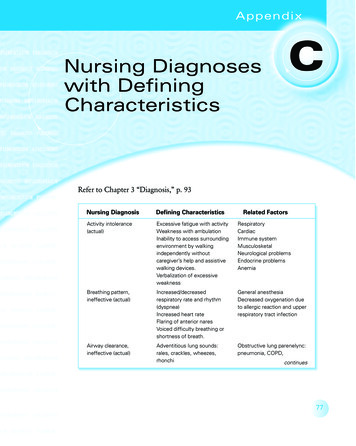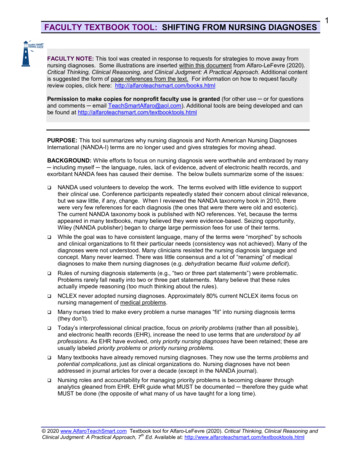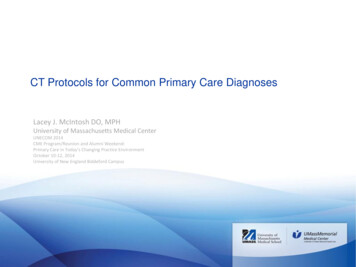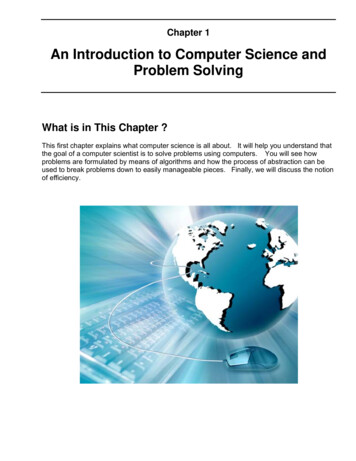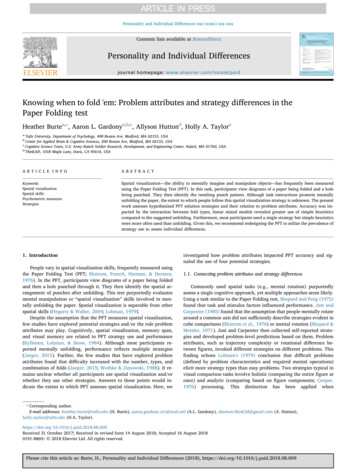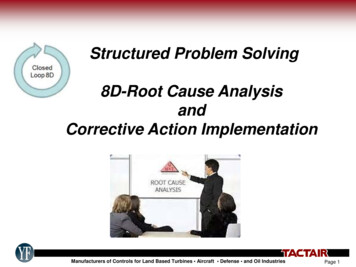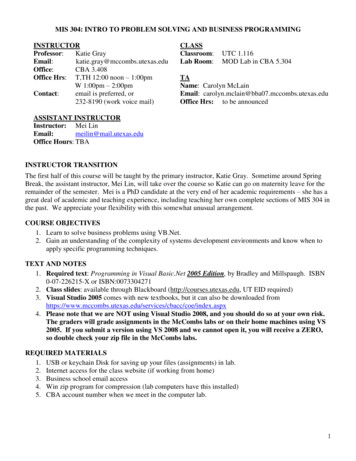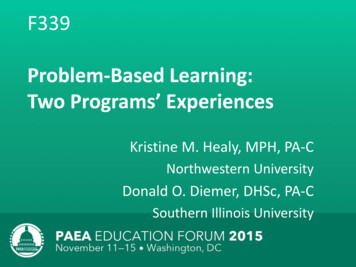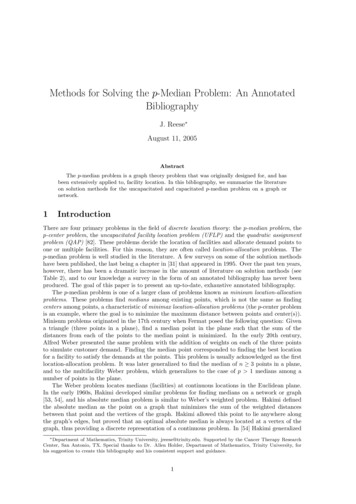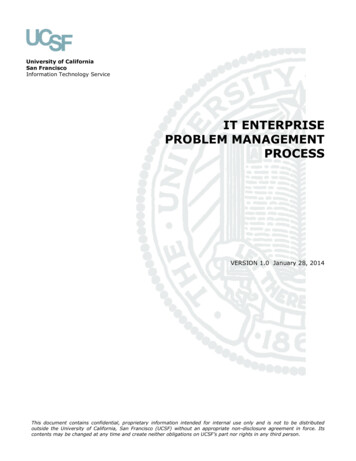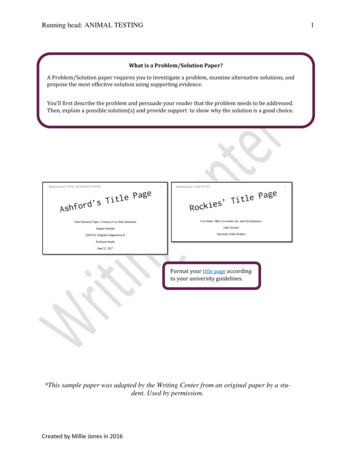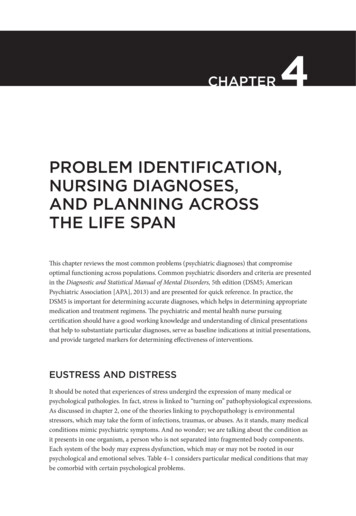
Transcription
CHAPTER4PROBLEM IDENTIFICATION,NURSING DIAGNOSES,AND PLANNING ACROSSTHE LIFE SPANThis chapter reviews the most common problems (psychiatric diagnoses) that compromiseoptimal functioning across populations. Common psychiatric disorders and criteria are presentedin the Diagnostic and Statistical Manual of Mental Disorders, 5th edition (DSM5; AmericanPsychiatric Association [APA], 2013) and are presented for quick reference. In practice, theDSM5 is important for determining accurate diagnoses, which helps in determining appropriatemedication and treatment regimens. The psychiatric and mental health nurse pursuingcertification should have a good working knowledge and understanding of clinical presentationsthat help to substantiate particular diagnoses, serve as baseline indications at initial presentations,and provide targeted markers for determining effectiveness of interventions.EUSTRESS AND DISTRESSIt should be noted that experiences of stress undergird the expression of many medical orpsychological pathologies. In fact, stress is linked to “turning on” pathophysiological expressions.As discussed in chapter 2, one of the theories linking to psychopathology is environmentalstressors, which may take the form of infections, traumas, or abuses. As it stands, many medicalconditions mimic psychiatric symptoms. And no wonder; we are talking about the condition asit presents in one organism, a person who is not separated into fragmented body components.Each system of the body may express dysfunction, which may or may not be rooted in ourpsychological and emotional selves. Table 4–1 considers particular medical conditions that maybe comorbid with certain psychological problems.
1 02PSYCHIATRIC–MENTAL HEALTH NURSING REVIEW AND RESOURCE MANUAL, 5TH EDITIONTABLE 4–1.PHYSICAL AND PSYCHOLOGICAL PRESENTATIONS: CHICKEN OR EGG?CardiovascularP MigraineP Essential hypertensionP AnginaP Tension headachesMusculoskeletalP Rheumatoid arthritisP Low back painP Multiple sclerosis: anxiety, depression, euphoria, ataxia, muscle weakness,diffuse neurological signs with exacerbations and remissionsRespiratoryP HyperventilationP AsthmaEndocrineP HyperthyroidismP DiabetesP ImpotenceP FrigidityP Premenstrual syndromeP Cushing’s syndrome: depression, insomnia, emotional lability, mania,psychosisP Adrenocortical insufficiency: lethargy, depression, psychosis, delirium,anorexia, nausea, vomitingP Hyperthyroidism: nervousness, irritability, insomnia, pressured speech,fear, impending death, anxiety disorders, psychosis, heat intolerance,diaphoresis, tremorP Hypothyroidism: lethargy, depression, anxiety disorders, paranoia,psychosis, cold intolerance, dry skin, apathyP Hyperglycemia: anxiety, agitation, delirium, acetone breathNeurologicalP Tumor: judgment, seizures, loss of speech, or smellP Frontal lobe syndrome: mood or personality changes and irritabilityIntegumentaryP NeurodermatitisP EczemaP PsoriasisP PruritusImmunologyP AIDS: depression, personality changes, impaired memory, mutism,progressive dementia, mania, deliriumGastrointestinalP AnorexiaP Peptic ulcerP Irritable bowel syndromeP ColitisP ObesityP Thiamine deficiency: confusion, confabulation, decreased concentration,neuropathy, Wernicke-Korsakoff’s psychosis P Vitamin B12 deficiency: irritability, pallor, dizziness, ataxia, fatigue
PROBLEM IDENTIFICATION, NURSING DIAGNOSES, AND PLANNING ACROSS THE LIFE SPANTRAUMA-INFORMED CARETrauma is an overwhelming event that affects feelings of safety, creates a sense of helplessness,and continues to affect ones perception of reality. The World Health Organization (2014) notesthat exposure to trauma and stress at a young age, in addition to genetics, nutrition, perinatalinfections, and exposure to environmental hazards can cause mental disorders. Traumainformed care models provides an important framework that focuses nurses to an understandingof impacts to the brain amygdala and stress hormone activation that results from traumaexposure.Otto Rank’s (1957) psychoanalytical speculation posited that our first experience with traumaoccurred during the trauma of birth, reflected in recovery-based language expressions such aswanting to feel “new born” or “born again.” Even earlier, consider the fetal environment duringorganogenesis and its effect on optimal neurological development. Did the mother-to-be havean optimal or non-optimal natal time frame? How might experiences of fear, abuse, and safetycompromise the developing neonate? How about considering how historically laden traumaexperienced by ancestors (slavery, Holocaust, genocide) actually may have altered the DNAstructure within previous generations? Young infants and children who witness, or are victimsof violence and violent acts experience triggered amygdala and HPA hormonal storms thatmay rewire the brain to heightened sensitivity. Impaired resilience and increased sensitivityto stress triggers to offspring may result. Manifestations may be apparent with observations ofsleep disorders, learning and behavioral difficulties, or development of other traumatic anxietydisorders (see Anxiety Disorders on page 117). Sources estimate that 70% of U.S. adults haveexperienced some type of traumatic event at least once in their lifetimes with 20% going on todevelop post-traumatic stress disorder (http://www.nurseptsdtoolkit.org/ /moreInfo/3.php).Stress is understood as a normal life occurrence that is to be expected. The goal, therefore, is toidentify how to cope with stress by engaging in adaptive responses rather than not coping, byengaging in maladaptive responses. A basic application of understanding stress is awareness thateach patient experiences some level of stress by virtue of entering the unknowns involved inhospitalization or engagement with a healthcare provider. Personal control is often either givenup or shared with a healthcare provider who is perceived as powerful and able to detect problemsthat people may be very sensitive about. By the same token, the nurse also experiences some levelof stress and anxiety in patient encounters because of similar unknowns. With this reality outand on the table, it is paramount that the educated nurse take responsibility for setting a tone oftrust-building though acceptance, openness, expressed concern, and compassion.As discussed in chapter 2 in reference to the HPA axis, Hans Selye (1956) brought forth atheoretical explanation for stress as it is experienced, describing three stages of alarm, resistance,and exhaustion. Consider the tenets of Stuart (2009) regarding a model of stress adaptation.Stuart’s stress adaptation model requires the psychiatric–mental health nurse to work with thepatient to identify biological, psychological, environmental, legal, ethical, sociocultural, andother risk factors that trigger a stress response in the patient. Any factor is a stressor if the patientperceives it to be so. The cognitive meaning, the affective feeling, the behavioral response, as well103
104PSYCHIATRIC–MENTAL HEALTH NURSING REVIEW AND RESOURCE MANUAL, 5TH EDITIONas the genetic predisposition of the patient-precipitant relationship are factors that will determinethe patient’s ultimate coping resources. These strengths and coping resources are drawn from aperson’s personal abilities, level of social support, material assets, and belief system. The nursewill explore these resources in planning care for the patient, as addressed later in this chapter.Criteria for diagnosing psychopathology are found in the Diagnostic and Statistical Manual ofMental Disorders, 5th edition (DSM5; APA, 2013).PSYCHIATRIC–MENTAL HEALTH PRACTICESTANDARD 2: NURSING DIAGNOSISSeveral diagnostic classification systems exist for identifying problems and specific directions ofcare for mental disorders. The resource for developing nursing diagnoses was developed by theNANDA International (NANDA-I). The NANDA-I classification system (NANDA International,n.d. a) was developed by nurses to identify problems treatable by nurses. NANDA-I nursingdiagnoses, unlike DSM5 (APA, 2013) diagnoses, identify the patient’s response to healthproblems, not the medical diagnosis. They are based upon the conceptualization of the humanresponse to actual or potential health problems from the unique nursing perspective. Thediagnosis is based upon an analysis and synthesis of collected data and the recognition offunctional patterns and trends. Nursing diagnoses allow for recognition of emergent and urgentproblems, patterns, and trends in comparison with normal standards. Diagnoses provide forprioritization; highest priorities are addressed first. An accurate diagnosis guides the direction oftreatment and evaluation of care outcomes (NANDA International, n.d. a, n.d. b). A partial listof NANDA-I–approved diagnoses that might apply to patients with mental disorders are listed inBox 4.1.Once problems have been identified and nursing diagnoses made, the psychiatric–mentalhealth nurse plans and implements nursing care addressing priorities for treatment. The highestpriority is given to conditions that, if untreated, could result in harm. These would includeconditions that involve basic survival needs or safety needs related to suicidal or homicidalideation (SI or HI) or threat of harm from others (e.g., domestic violence, child or elder abuse).Intermediate priority is given to nonemergent, non–life-threatening, but distressing, painful, ordysfunctional symptoms (e.g., hallucinations, agitation). Lower priority is given to issues that arenot specifically related to the illness or prognosis (e.g., occupational, social stressors). Maslow’shierarchy of needs can be used to conceptualize the priorities for care planning.The nursing care plan specifies, by priority, the diagnoses, short-term and long-term goals andexpected outcomes, and interventions, including the what, when, where, how, and who. Whenavailable, current, evidence-based practice guidelines, clinical pathways, or clinical algorithmscan be used. When new or unusual care needs arise, the nurse is advised to use current researchto identify evidence-based approaches. In planning for safe and effective quality care, the JointCommission (2015) establishes annual Behavioral Health Care National Patient Safety Goals:
PROBLEM IDENTIFICATION, NURSING DIAGNOSES, AND PLANNING ACROSS THE LIFE SPANBOX 4.1. SELECT LISTING OF NANDA-I NURSING DIAGNOSESP Anxiety (mild, moderate, severe, panic)P Adjustment, impairedP Posttraumatic syndrome or riskP Rape trauma syndromeP Confusion (acute, chronic)P Coping (ineffective, readiness forenhanced, compromised family, defensive)P Denial, ineffectiveP Relocation stress syndrome or riskP Role performance, ineffectiveP Decisional conflictP Family processes (dysfunctional,interrupted, readiness for enhanced)P FatigueP FearP Grieving (anticipatory, dysfunctional)P Health maintenance, ineffectiveP Health-seeking behaviorP HopelessnessP Identity, disturbed personalP Loneliness, risk forP Memory, impairedP Noncompliance; nonadherenceP Nutrition, altered; more or less than bodyrequirementsP Pain (acute, chronic)P Parenting (enhanced readiness, impaired,risk for impaired)P Self-care deficit (bathing, dressing,feeding, etc.)P Self-esteem (chronic low, situationallow, risk for low)P Self-mutilation or risk forP Sensory perception, disturbed or alteredP Sexual dysfunctionP Sexuality pattern, disturbedP Sleep pattern, disturbedP Social interaction, impairedP Social isolationP Sorrow, chronicP Spiritual distress, risk; readiness forP Suicide riskP Thought process disturbed or alteredP Trauma, actual or riskP Violence, risk for other- or self-directedP WanderingP Identify persons served correctly. Use at least two ways to identify individuals served.for example, use the individual’s name and date of birth. This is done to make surethat each individual served gets the correct medicine and treatment.P Use medications safely. Record and pass along correct information about a patient’smedicines. Find out what medicines the patient is taking. Compare those medicinesto new medicines given to the patient. Make sure the patient knows which medicinesto take when they are at home. Tell the patient it is important to bring their up-to-datelist of medicines every time he or she visits a doctor. Prevent infection. Use the goalsto improve hand cleaning.P Identify patient safety risks. Find out which individuals served are most likely to try tocommit suicide.105
106PSYCHIATRIC–MENTAL HEALTH NURSING REVIEW AND RESOURCE MANUAL, 5TH EDITIONPSYCHIATRIC–MENTAL HEALTH PRACTICESTANDARD 3: OUTCOMES IDENTIFICATIONOutcomes identify the desired results for improvements in patient functionality and well-beingthat are demonstrated from interaction with nurses and the healthcare environment. Guidelinesare constructed to lay out consistency of elements, and they can be measured along severaldimensions: clinical, functional, satisfaction, and financial.Outcomes are clear statements indicating what “will” happen for patients as a course of clinicalcare. Regardless of the dimension, each outcome considers these guidelines:P Patient and family-centered: focuses on diagnosis; suited to patient or population ofinterestP Singular: separate goals for each identified problem or needP Mutual: agreed upon by patient, family, or both and nurse, team, or healthcareprovidersP Measurable, reliable, valid: describes quality, quantity, severity, frequency(standardized assessment tools and scales)P Time-limited: set short- and long-term goalsP Realistic: attainable to provide a sense of accomplishment; sensitive to changes withinor between personsP Evidence-based: algorithms, practice guidelines, clinical pathwaysP Cost-effectiveSpecific outcomes criteria in keeping with Psychiatric–Mental Health Practice Standard 4:Planning will be presented with each psychiatric problem presented in this chapter.TABLE 4–2.OUTCOME DIMENSIONSCl
PSYCHiATRiC–MENTAL HEALTH NURSiNG REViEW AND RESOURCE MANUAL, 5TH EDiTiON. PSYCHiATRiC–MENTAL HEALTH PRACTiCE STANDARD 3: OUTCOMES iDENTiFiCATiON . Outcomes identify the desired results for improvements in patient functionality and well-being that are demonstrated from interaction with nurses and the healthcare environment. Guidelines are File Size: 321KBPage Count: 64
